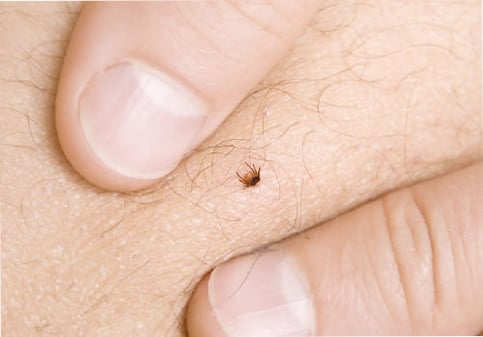About Lyme Disease
GLA Funded Research
Apply for Funding

Lyme disease is a complex infection that can affect various systems in the body including the joints, nervous system, heart, and skin. Unfortunately, without an expanding ring-like rash (the “hallmark” bull’s eye rash is the most common skin manifestation), Lyme and other tick-borne illnesses often go undiagnosed and untreated, leading to deep-seated infections and long-term impairments.

Many symptoms of Lyme are similar to other illnesses, which complicates diagnosis. The Centers for Disease Control and Prevention (CDC) recommends a two-step process when testing blood for evidence of antibodies against the Lyme bacterium. However, Lyme disease blood testing is fraught with problems, false negative results and false positives (false negatives could exceed 50%) and, at best, should only be an adjunct to a clinical diagnosis of the disease.
Do you live in an endemic area? And are you showing symptoms after a tick bite?
Early diagnosis is a key success factor for treating Lyme disease. If you think you are infected with Lyme disease, reach out to your healthcare provider and discuss a potential diagnosis of Lyme disease.
After an infected tick bite, a bullseye rash (erythema migrans) is one of the most common initial symptoms of Lyme disease. However, just because you do not have this rash after a tick bite, does not mean you are in the clear. A Lyme rash can even present itself as just a reddened area of skin. Stay on the cautious side without the presence of these symptoms and be aware of any possible Lyme symptoms after a possible deer tick bite.
And if you have a bullseye rash, do you have Lyme disease? Not necessarily. Other reasoning for this common Lyme symptom includes spider bites, drug reactions, ringworm, or allergic reactions to an insect bite.
According to the CDC, the diagnosis should be based upon your symptoms, medical history, tick exposure, and geographical area (“endemic” locations). Blood tests as a diagnostic test should only be used to provide supporting evidence for the diagnosis.
A report published in Clinical Infectious Diseases acknowledges the need for better laboratory tests. Newer approaches in direct detection show promise and could help thousands of people with Lyme to get the treatment they need.
Join our community of advocates by subscribing to our newsletter—stay informed with the latest breakthroughs in Lyme disease research and news. Ready to take the next step? Your donation to Global Lyme Alliance fuels the fight for a cure.
Subscribe Now to stay involved, or Donate Today to help us overcome Lyme disease.
After a suspected tick/insect bite, if you see a rash(es), even if it’s not at the site of the bite, you or your physician should take a picture of it, date it, and the doctor should place a copy of it in your medical records.
It is important to keep a log, timing the start of the symptoms and keeping track of those that come and go over time. Fluctuating symptoms are hallmarks of Lyme disease. The log should also contain a record of when all medications (including non-prescription) are begun, ended, or have a dosage change.
Unlike adults, children with Lyme disease often can’t explain what feels wrong. They suffer when their bodies hurt, when they can’t get enough sleep at night, when they struggle at school, when they don’t feel like playing. Because some of their symptoms, such as irritability, joint aches and difficulty concentrating, can mirror “growing pains,” legitimately sick children are often told that their problems are “all in your head.” Parents and teachers may suspect the child or adolescent is simply trying to avoid schoolwork, daydreaming, or acting up, when, in fact, a tick-borne illness might be the cause.
Without diagnosis and persistent symptoms, Lyme disease can be present in your body after the initial infection for weeks, months, or even years. It is best to catch early Lyme disease before it progresses to a later stage or chronic Lyme disease. If you were bitten by a tick and have any clinical signs, be sure to follow the best practices above and see a Lyme-literate doctor.
There are ways to prevent the bacterial infection of Lyme disease and other tick-borne diseases, including insect repellent in wooded areas and during outdoor activities. Learn more about preventing Lyme disease and other tick borne diseases with Global Lyme Alliance.
From chronic fatigue syndrome, swollen lymph nodes, Lyme arthritis, to common flu-like symptoms, Lyme disease has more than 100 symptoms. Varying symptoms, combined with the fact that blood tests are highly inaccurate, contribute to the difficulty in diagnosing Lyme disease.
If you are diagnosed with Lyme disease, there are treatment options, including antibiotic treatment. Check out the different common courses of treatment with GLA.
Lyme disease is relentless, but so are we. Your donation powers the research that leads to breakthroughs and patient service programs that prevents suffering. Stand with us in the fight—your contribution can create lasting change and future relief for so many.
Donate Today and Be a Part of the Solution.
2023 © Copyright Global Lyme Alliance. All rights reserved.
Disclaimer: The above material is provided for information purposes only. The material (a) is not nor should be considered, or used as a substitute for, medical advice, diagnosis, or treatment, nor (b) does it necessarily represent endorsement by or an official position of Global Lyme Alliance, Inc. or any of its directors, officers, advisors or volunteers. Advice on the testing, treatment or care of an individual patient should be obtained through consultation with a physician who has examined that patient or is familiar with that patient’s medical history. Global Lyme Alliance, Inc. makes no warranties of any kind regarding this Website, including as to the accuracy, completeness, currency or reliability of any information contained herein, and all such warranties are expressly disclaimed.